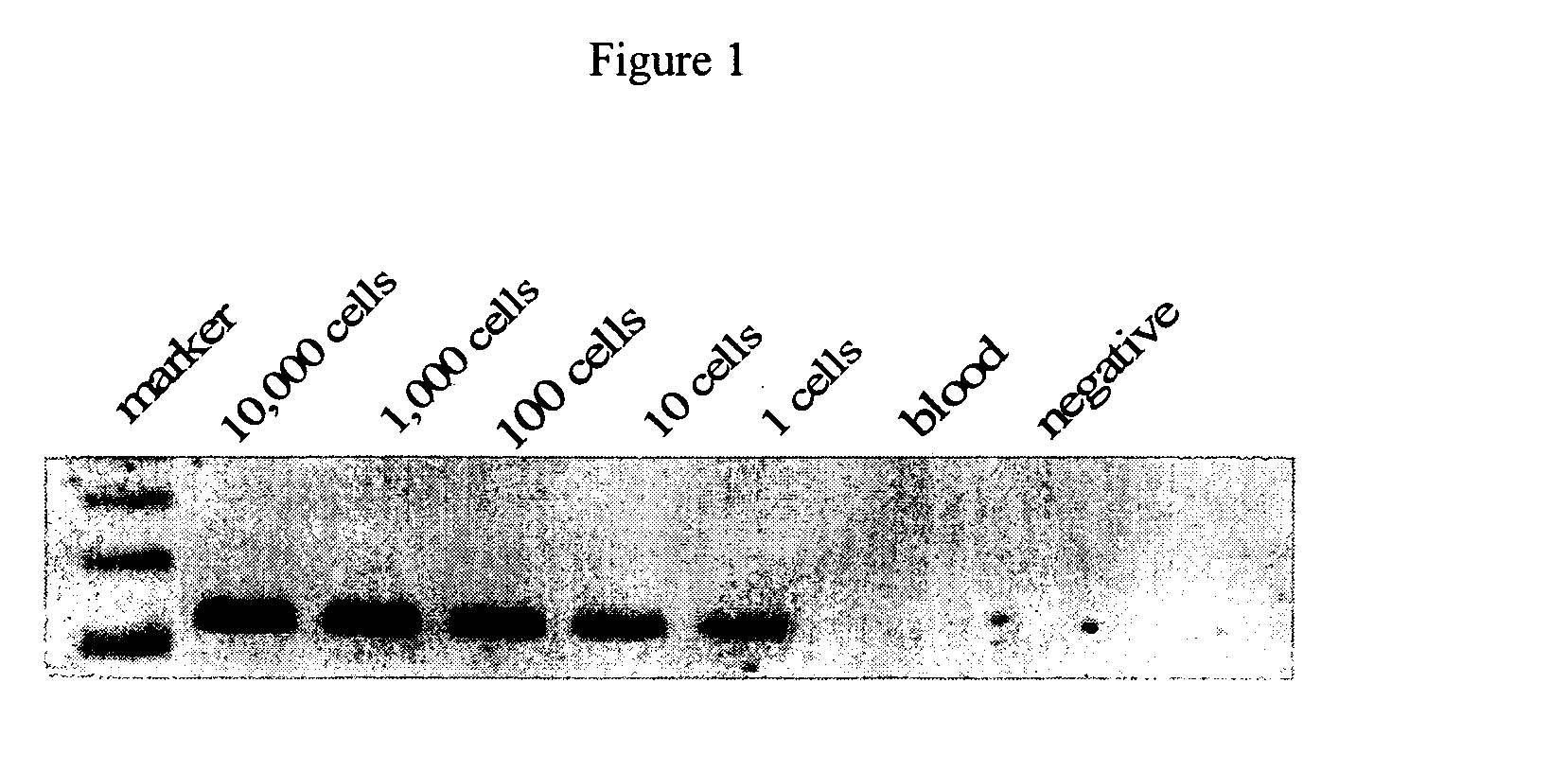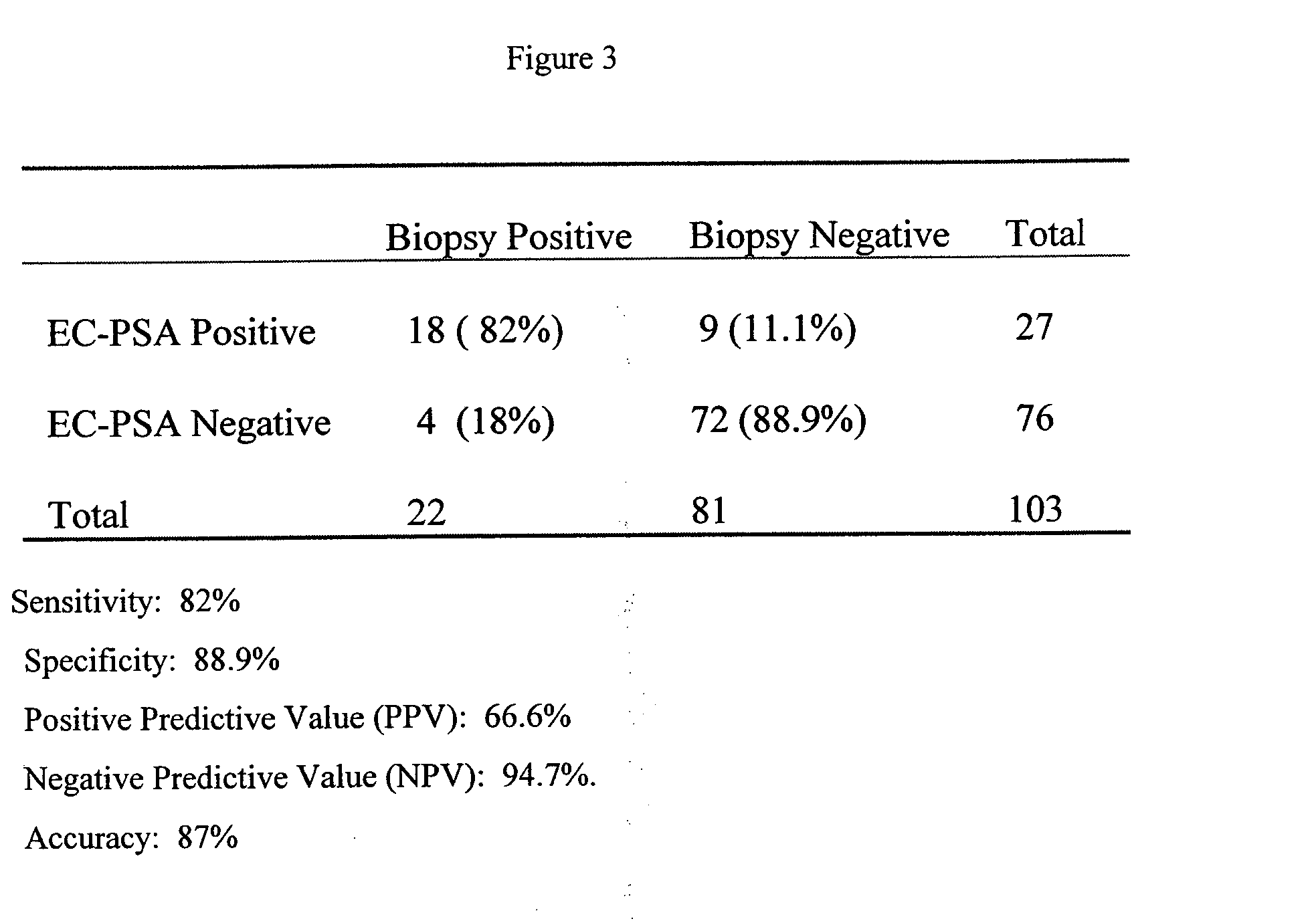Enhanced diagnostic potential of prostate-specific antigen expressing cells
a prostate-specific antigen and diagnostic potential technology, applied in the field of enhanced diagnostic potential of prostate-specific antigen expressing cells, can solve the problems of metastatic spread of cap in a significant percentage of prostate cancer patients, poor patient prognosis, and imperfect psa test results
- Summary
- Abstract
- Description
- Claims
- Application Information
AI Technical Summary
Problems solved by technology
Method used
Image
Examples
example 1
Immunomagnetic Capture of Epithelilal Cells from Blood and RNA Preparation
[0039] Five milliliters of blood was collected into a sodium citrate tube and transported to the laboratory on wet ice within 2-3 hours after the blood was drawn. Dynabeads coated with monoclonal antibody, Ber-EP4 specific for immunomagnetic enrichment of human epithelial cells (Dynal, product number: 116.02), were mixed thoroughly in the vial. Eighty micro-liters of Dynabeads suspension was transferred to a 0.5 ml Eppendorf tube, placed on a Dynal MPC rack for 2 minutes and the supernatant pipetted off. One-half ml of cold washing buffer [2% heat inactivated fetal bovine serum (FBS) in phosphate-buffered saline (PBS)] was added to the beads, the tube was removed from the rack, beads were resuspended and the supernatant was removed by placing the suspension in the MPC rack as before. Beads were finally suspended in 80 .mu.l of the washing buffer and added into 5 ml of blood followed by gentle tilting and rotat...
example 2
Confirmation of Assay Sensitivity
[0046] To confirm the sensitivity of the protocol, 1 ml of normal human female blood was spiked with a known number of LNCaP cells. The detection limit of ERT-PCR / PSA assay was as low as one cell in 1 ml of blood. Briefly, sensitivity of the ERT-PCR / PSA assay was determined by serial dilutions of total RNA derived from a known number of LNCaP cells spiked into total RNA of a known number of peripheral blood mononuclear cells (PBMC) at LNCaP / PBMC cell ratios of 1:10.sup.2, 1:10.sup.3, 1:10.sup.4, 1:10.sup.5, 1:10.sup.6, 1:10.sup.7, 1:10.sup.8, 1:10.sup.9. The PCR amplification product was detected by ethidium bromide staining of agarose gels. The limit of ERT-PCR / PSA in this assay was 1:10.sup.7. The sensitivity of the assay from the analysis of peripheral blood was illustrated in representative experiments which are shown in FIG. 2.
[0047] Using primers specific for the PSA gene, sensitivity was defined as the detection of the number of prostate cance...
example 3
Analysis of PSA Expressing Cells in Peripheral Blood of Prostate Cancer Patients
[0048] In 85 patients undergoing radical prostatectomy, a minimum of two independent ERT-PCR / PSA assays detected circulating prostate cells preoperatively in 27 patients (31.8%). In 12 locally advanced or advanced stage patients, ERT-PCR / PSA was positive in 5 patients (41.7%), and in 22 controls, no patient was ERT-PCR / PSA positive. In 10 randomly selected cases, the RT-PCR product was confirmed as PSA by DNA sequencing. Of the 27 RT-PCR positive RP patients, 11 of 27 (40.7%) had non-organ confined disease (.gtoreq.pT3a), and of the 58 RT-PCR negative patients, 32 (55.2%) had non-organ confined disease. RT-PCR positive patients also had lower margin positivity (9 of 27, 33.3%) than did RT-PCR negative patients (21 of 58, 36.2%). Finally, at a mean follow-up of 25.7 months, 5 of 27 (18.5%) RT-PCR positive patients recurred (PSA) compared to 14 of 58 (24.1%) RT-PCR negative patients. The results of represe...
PUM
| Property | Measurement | Unit |
|---|---|---|
| volume | aaaaa | aaaaa |
| time | aaaaa | aaaaa |
| volume | aaaaa | aaaaa |
Abstract
Description
Claims
Application Information
 Login to View More
Login to View More - R&D
- Intellectual Property
- Life Sciences
- Materials
- Tech Scout
- Unparalleled Data Quality
- Higher Quality Content
- 60% Fewer Hallucinations
Browse by: Latest US Patents, China's latest patents, Technical Efficacy Thesaurus, Application Domain, Technology Topic, Popular Technical Reports.
© 2025 PatSnap. All rights reserved.Legal|Privacy policy|Modern Slavery Act Transparency Statement|Sitemap|About US| Contact US: help@patsnap.com



